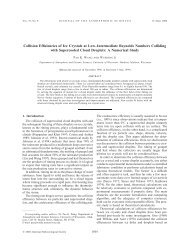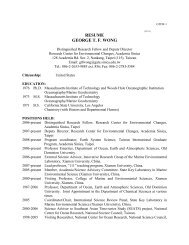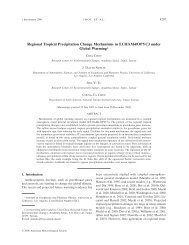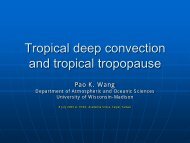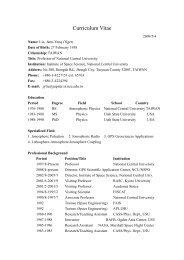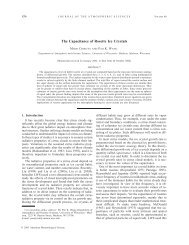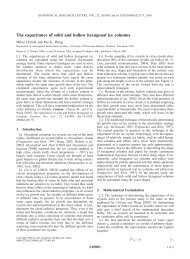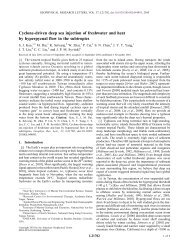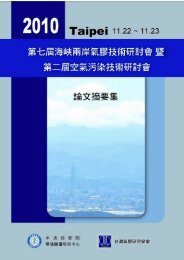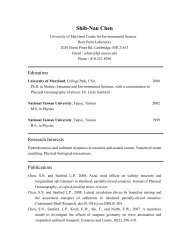Collection of Aerosol Particles by a Conducting Sphere in an ...
Collection of Aerosol Particles by a Conducting Sphere in an ...
Collection of Aerosol Particles by a Conducting Sphere in an ...
- No tags were found...
You also want an ePaper? Increase the reach of your titles
YUMPU automatically turns print PDFs into web optimized ePapers that Google loves.
COLLECTION OF AEROSOL PARTICLES 311x lj& ,,,( ,,,,/,,,,,,,,,,,,/,, I2. 5. .Ol 2. 5. .I 2. 5.RRDIUS OF PRRTICLE [MICRONSI,,,, (,,,, ,,,~;I:FIG. 9. <strong>Collection</strong> kernels <strong>of</strong> aerosol particles captured <strong>by</strong> spheres <strong>of</strong> various sizes due to Browni<strong>an</strong>diffusion <strong>an</strong>d electric forces <strong>in</strong> air <strong>of</strong> 900 mbar <strong>an</strong>d 10°C <strong>an</strong>d external electric field Ea = 100 V/cm.(1) a = 10 pm, (2) a = 30 pm, (3) a = 50 pm, (4) a = 70 pm, (5) a = 100 pm, (6) a = 200 pm,(7) a = 300 pm, (8) a = 400 pm. Ventilation effects are <strong>in</strong>cluded. Q = 2a2 esu, q = 2rz esu, a <strong>an</strong>d ri,<strong>in</strong> centimeters.testify <strong>an</strong> old empirical rule that the sum <strong>of</strong>the pure Browni<strong>an</strong> flux <strong>an</strong>d pure conductioncurrent represents a good approximation forthe total flux <strong>in</strong> m<strong>an</strong>y cases.a. Limit<strong>in</strong>g CasesWe shall now show that <strong>in</strong> various limit<strong>in</strong>gcases the solutions <strong>in</strong> Sections 2 <strong>an</strong>d 3 c<strong>an</strong>be reduced <strong>an</strong>d c<strong>an</strong> represent the proper solutionsfor these limits.(i) When there is no external field (EO= 0). In this case, t = 1 <strong>in</strong> Eq. [23] <strong>in</strong>stead<strong>of</strong> zero, <strong>an</strong>d Eq. [24] becomes exactly[441while Eq. [30] also reduces exactly to thisresult. This is identical with the solution obta<strong>in</strong>ed<strong>by</strong> (8) where the particle distributionis determ<strong>in</strong>ed only <strong>by</strong> the Browni<strong>an</strong> diffusion<strong>an</strong>d central forces such as that caused <strong>by</strong>static charges.(ii) Pure Browni<strong>an</strong> dljiision. When bothelectric forces due to the external field <strong>an</strong>dthe electric charges are absent, then the particledistribution is solely determ<strong>in</strong>ed <strong>by</strong> theBrowni<strong>an</strong> diffusion. We c<strong>an</strong> obta<strong>in</strong> this fromthe above solutions.S<strong>in</strong>ce there is no external electric field, thestart<strong>in</strong>g equation will be the same as Eq. [44].We then take the limit <strong>of</strong> Eq. [44] when Q<strong>an</strong>d q are <strong>in</strong>f<strong>in</strong>itely approach<strong>in</strong>g zero. Thus,<strong>by</strong> exp<strong>an</strong>d<strong>in</strong>g the exponential functions <strong>in</strong>[44] <strong>in</strong>to power series we obta<strong>in</strong>



